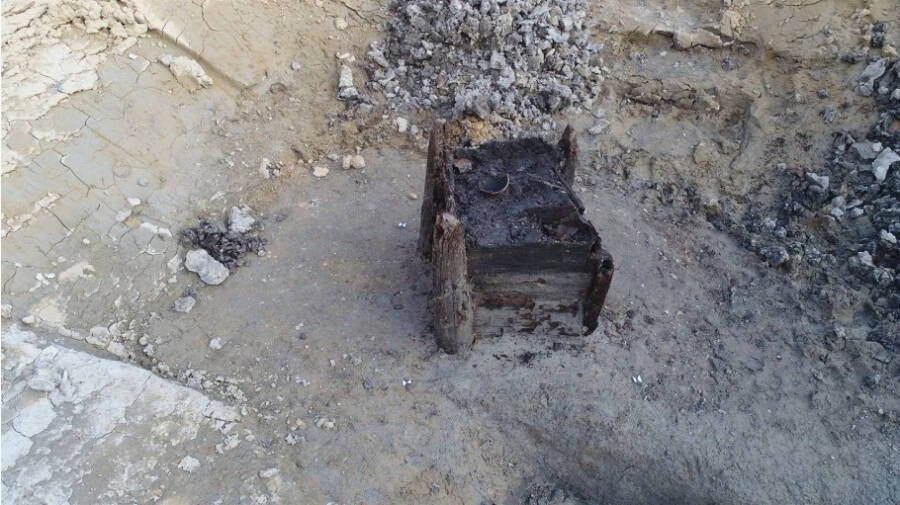Experts were stunned by the level of craftsmanship and precision in something built using only stone, bone, and wooden tools.

Archaeological Centre OlomoucThe ancient water well was discovered in 2018 during construction of the Czech Republic’s D35 highway.
The crumbling wooden water well above certainly doesn’t look impressive, but a tree-ring dating method revealed the oak used to build it is 7,275 years old. That might make it the oldest known wooden structure in the world confirmed using this method.
“According to our findings, based particularly on dendro-chronological data we can say that the tree trunks for the wood used were felled in the years 5255 and 5266 B.C.,” said Jaroslav Peška, head of the Archaeological Centre Olomouc. “The rings on the trunks enable us to give a precise estimate.”
According to Radio Prague International, the well was discovered in the town of Ostrov in 2018, during construction on the Czech Republic’s D35 highway. Though the ceramic remnants found inside dated the site to the early Neolithic period, no evidence of settlements were discovered nearby.
“We believe it was used by settlers during what we call the Neolithic Revolution, during a transition from a lifestyle of hunting and gathering to one of agriculture and settlements,” said Peška. “These people likely built simply-structured houses and domesticated animals.”
The lack of settlement signs near the well suggested it was used by several settlements that were located some distance away. Preservation of the well itself was due to its centuries-long submersion. Filled with dirt, an animal horn, and bird bones, it was carefully unearthed in one piece.

Rybníček et al., J. Archaeol. Sci., 2020Some of the wooden poles were felled earlier than the others, suggesting they were used previously for something else before being repurposed.
Published in the Journal of Archaeological Science, the findings detailed the well’s fairly sophisticated construction. Built with an oak pole at each corner and flat planks of wood between them, it measured 2.62 feet by 2.62 feet and stood 4.6 feet tall.
A shaft protruded out the bottom and into the ground to reach the groundwater below. Peška was rather impressed by its design.
“The construction of this well is unique,” he said. “It bears marks of construction techniques used in the Bronze and Iron ages and even the Roman Age. We had no idea that the first farmers, who only had tools made of stone, bones, horns, or wood, were able to process the surface of felled trunks with such precision.”
Two of the poles were felled three to nine years earlier than the others, suggesting they were previously used elsewhere before being repurposed for the well. One of the planks, too, was felled earlier, between 7,261 and 7,244 years ago. Experts believe this was due to a repair on the well.
While it isn’t official that it’s the oldest wooden structure still in existence, the research team makes a solid case. Though there are over 40 of these wells across Europe dating to similar timeframes, those dating estimates weren’t based on dendrochronology.

Archaeological Centre OlomoucThe ancient artifact is now being preserved with plain white sugar. It will be put on display at the Pardubice Museum in about two years.
For Peška, the craftsmanship used to build the well and the ingenuity it displays is most remarkable part of the discovery.
“The available technology, i.e., tools made of stone, bones, horn or wood, was sufficient for sophisticated carpentry,” he said. “Comparing the structure of the Ostrov well with examples of carpentry from later periods raises nothing less than admiration for the perfectly precise work.”
As it stands, researchers have replaced the water the well was submerged in with plain white sugar to ensure the artifact continues to be preserved.
“The wooden planks are submerged in this sucrose solution and will stay there for several months,” explained Peška. “During that time the damaged cellular structure of the wood will be replaced by sucrose, whose chemical composition is similar to cellulose in wood.”
“After that it will be fixated and only then can the well be displayed in Pardubice Museum as earlier agreed. Altogether, the restoration process should take about two years.”
After learning about the well that might be the oldest known wooden structure still in existence, read about archaeologists uncovering 3,000-year-old Scottish weapons under a soccer field. Then, learn about brewers using yeast found in a 220-year-old shipwreck to create the “world’s oldest beer.”





